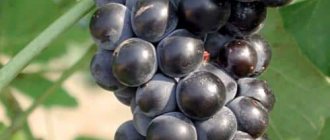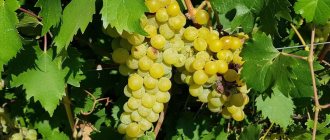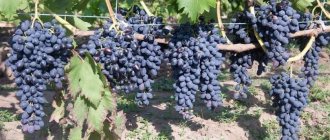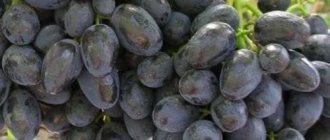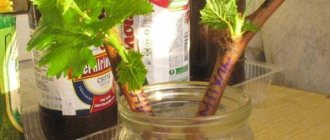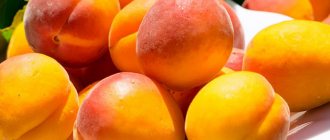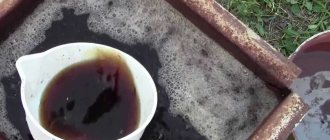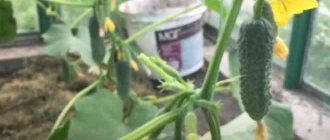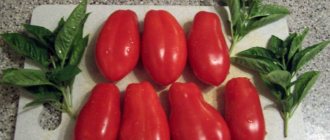Blagovest characteristics table
| General information about the Blagovest variety | |
| Blagovest parent couple | Talisman × Radiant Kishmish |
| Author of the variety: | Amateur selection by V.N. Krainov, Russia |
| Main characteristics of Blagovest | |
| Purpose: | dining room |
| Ripening time: | mid-early |
| Productivity: | high |
| Taste: | light nutmeg, with a hint of duchess |
| Color: | amber, yellow-green |
| Frost resistance: | up to — 22°C |
| Description of a bunch of grapes | |
| Bunch weight: | 800-1200 gr. |
| Bunch density: | average |
| Description of grapes | |
| Berry shape: | oval |
| Berry weight | 12-14 gr. |
| Diseases | |
| Disease resistance: | Resistance to mildew - 3.5-4.0 points. |
The Blagovest grape variety has become known among Russian amateur breeders quite recently. It was obtained by crossing two popular table varieties - Talisman, Kishmish radiant, as a result of breeding experiments by winegrower V. Krainov, a resident of Novocherkassk. This form is one of the first that were created by this author. The variety has received good reviews from experienced, professional gardeners due to its high yield, fertility, and also very good appearance.
In this article we will tell you about Blagovest grapes - a detailed description of the variety, photos and reviews that objectively characterize this form.
Description and appearance of the Blagovest variety
Grapes of this variety are grown in regions with a southern or temperate climate. Let's look at a more detailed description below.
Appearance of Blagovest grapes
Bush and vine
The shrub is quite strong and tends to grow. The vine is usually medium to vigorous and light brown in color.
The shoots are strong and have a light green tint. The leaves of the plant are dissected and dark green in color.
Flowering period
Flowers are bisexual, active self-pollination. Flowering occurs in early to mid-June. 3-4 inflorescences usually appear on one shoot.
"Blagovest" is not prone to peas. There is a predisposition to compaction of bunches.
bunches
The bunches are quite large, one weighs 1-1.2 kg. Sometimes a mature bunch reaches a weight of up to 3 kg.
The clusters have the shape of a slightly elongated cone or a rounded cylinder. The density is different - loose or dense.
Berries
The grapes are large and oval. They grow up to 3 cm in length, with an average weight of up to 15 g. The color is green with a hint of yellow. If the fruits are exposed to the sun, the colors change to bright amber shades after ripening.
The skin is dense and does not crack when the bunches hang on the vine for a long time. The pulp is juicy. The taste is duchess, there are nutmeg notes. The seeds are small.
Diseases and pests
According to the description, this hybrid is not prone to infection with garden diseases. Among all the diseases, only gray mold, mildew and oidium are dangerous. But if preventive treatments of planted bushes are carried out with Bordeaux mixture (3-4 times per season), the likelihood of signs of the disease appearing is minimized.
If signs of a plant being affected by one of the diseases appeared, this was due to an error in caring for the planted crop. Mildew and Oidium are diseases that actively develop in thickened vineyards. Therefore, the deciduous mass and unnecessary vines will have to be thinned out. And to restore immunity, plants are sprayed with a 1 or 2% solution of Bordeaux mixture.
Pests rarely attack the fruits and foliage of the plant. The greatest danger is posed only by wasps, which often hover around ripe bunches of planted crops. It's difficult to fight them. The best methods of counteraction are timely harvesting (which is often impossible to do due to unbalanced ripening of fruits on the bush) or the use of special nets in which the clusters hanging on the shoots are placed.
Agrobiological characteristics
| Characteristics | "Blagovest" |
| Drought resistance | average |
| Frost resistance | -24°С |
| Sugar content | more than 20% |
| Aroma | Duchess |
| Productivity | On average 10 kg per bush |
| Fresh consumption | Maybe |
| Raw materials for wine | Yes |
| Transportability | high |
Light grapes "Blagovest"
The Blagovest grapes are the result of amateur selection. Novocherkassk amateur breeder Krainov V.N. received this hybrid table variety in 1995 by crossing the grapes “Kishmish radiant” and “Talisman”. “Blagovest” received the best characteristics from the parent couple. The variety immediately attracted the attention of winegrowers, thanks to its high yield and large, beautiful clusters.
"Blagovest": description of the variety
“Blagovest” is a light grape, depending on the amount of sun it can be greenish or yellow with an amber tint. Like most modern hybrid varieties, it has large fruits, the weight of the berries reaches 12-14 grams. They have an oval, slightly elongated shape. The pulp is juicy and crisp, has a pleasant nutmeg taste and a subtle aroma of duchess. The skin is thin and you can barely feel it when eating the berries. The variety has a high sugar content: 19-22%, acidity is 6-8%. Due to its high sugar content, Blagovest is an attractive treat for wasps.
Rules and features of landing
Let's look at the rules for planting the Blagovest grape variety. Photo:
How to plant and care for Blagovest grapes
Site selection and preparation
"Blagovest" grows well on fertile chernozem and sandy soils. The growing area should be well lit and protected from draft winds.
Recommended time for disembarkation
Planting cuttings can be done in both autumn and spring. In the latter case, planting should be done before the growing season begins.
The plant tolerates temperature changes calmly. The main thing is to avoid frost at the time of planting.
How to select seedlings
Before planting, the cuttings should be shortened by 2-3 eyes and the root shoots should be slightly trimmed. If there are more than 2 shoots on the cutting, then you need to leave only the tallest one among them. The day before planting, the cuttings are placed in a mixture prepared from mullein.
Planting process
Landing occurs as follows:
- dig a hole 80 cm wide and the same depth;
- You need to lay the soil mixture at the bottom of the dug hole;
- it is necessary to straighten the roots and install the cutting in the hole;
- sprinkle with earth and compact lightly;
- water with warm water and mulch the hole.
Cultivation and care technology
Blagovest grapes are unpretentious and caring for the plant does not require much labor or time. However, to obtain a large harvest, you should familiarize yourself with some of the features of its cultivation.
Features of caring for Blagovest
Watering
Young grape bushes need regular watering, especially if they have not yet taken root. Watering should be done once every 2 weeks, but you need to pay attention to the weather. Water should not be poured under the root. You should make holes 50 cm from the bush and water from there.
Mature bushes also need watering, especially if there is a dry season. At least 5 buckets of water are poured under the grape bush. When to water:
- The first watering is carried out until the leaves bloom.
- The second watering is required 2-3 weeks before the bush blooms.
- The third is when the fruits grow to the size of peas.
- The fourth - a month before the first harvest.
- The fifth watering should be done after leaf fall, if it is a dry autumn. In case of rain there is no need for it.
ATTENTION! After watering, you need to loosen the soil around the trunk. This will provide air flow to the grape roots.
Feeding and fertilizers
The yield of grapes largely depends on what kind of nutrition the bush received. Feeding the plant should begin in the 2nd year after it is planted in open ground.
It is recommended to use mineral fertilizers. The first fertilizing is applied even before flowering. Then, during the growing season, you need to add 2 more fertilizings - once a month.
ATTENTION! Read the instructions for use carefully before using fertilizers.
Pruning shoots
It is advisable to prune the Blagovest variety in the fall, after all the leaves have fallen from the bush. No more than 30 young shoots are left on an adult plant to ensure an even load. Each shoot is cut into 8-9 eyes. Next, a vine is formed from the shoots.
Spring pruning is not recommended. However, if there are frozen branches, they should be removed.
ATTENTION! Pruning is carried out with sharp pruning shears so as not to damage the shoots. The shoot is cut in the direction from the eye.
Normalization
The Blagovest variety has its own peculiarity - a large number of fruit-bearing shoots are often observed on one bush, and 3-4 inflorescences grow on each shoot. All this is fraught with overload when ripening berries. For this reason, the bush needs normalization.
During the first 2 years, all the inflorescences are cut off from the bushes, leaving 1-2 signal clusters. Over the next 3 years, excess inflorescences are removed and only 1 brush is left, the strongest and largest.
An adult bush will also not withstand overload. The berries will be smaller, the taste will be distorted and the harvest will ripen later. Excess inflorescences should be removed, otherwise the plant will spend the next few years recuperating.
Protection from diseases and pests
"Blagovest" is highly resistant to plant diseases. If not properly cared for, the plant may be affected by oidium or mildew.
To reduce the risk of mildew infection, it is necessary to monitor the thickening of leaves and shoots, destroy weeds and make a green garter in a timely manner. As a preventative measure, you can spray the bushes with Bordeaux mixture (1% solution). This processing is carried out in 3 stages:
- The first spraying is carried out when 4-5 leaves appear on each shoot.
- The second spraying is before flowering.
- The third and subsequent sprayings - every time after rain.
Colloidal sulfur will help get rid of oidium. It is necessary to prepare a solution and spray it on the affected parts of the plant.
Sweet berries are often targeted by wasps. To protect the crop from these insects, it is necessary to place each bunch in special gauze bags. You can also make a trap: place a jar of sugar near the bush to distract the wasps from the berries.
Preparing for winter
Young Blagovest bushes need to be covered for the winter in case of severe frosts. They do this as follows:
- shoots are carefully tied;
- boards are placed on the ground and tied shoots are placed there;
- arcs made of wire or rods are installed on top;
- cover everything with covering material (tar paper, burlap) and secure them on the sides;
- a couple of holes are made in the covering material for air circulation.
In the spring, when the weather becomes warm enough, the covering material is removed and the vine is tied to a trellis.
ATTENTION! Mature bushes do not need shelter and can easily tolerate cold temperatures down to -24°C. If the region experiences cold winters above the specified temperature, the plant should be covered.
Characteristic features of the variety
The specificity of the Blagovest grape variety is the formation of a large number of inflorescences on one fruiting shoot. There are 3-4 of them formed, as can be seen in the photo of the grapes. The description states that bushes under 5 years of age cannot bear such a load. Experienced winegrowers carry out mandatory rationing of Blagovest vines.
Advice! On one fruiting shoot you need to leave one flower cluster, choose the largest one.
Even in the same climate zone, reviews about the ripening time of this grape variety may differ. They directly depend on the load of the bush. For the Blagovest bush that blooms for the first time, no more than 2 inflorescences are left. In the first year of fruiting, 1-2 signal clusters are produced.
Drought resistance, frost resistance
In the description of the variety, the general frost resistance of Blagovest grapes is estimated at -22 °C. This is the average. Weather disasters reduce this characteristic:
- frequent and prolonged thaws;
- the sudden onset of winter.
Despite the good frost resistance of the variety, Blagovest grapes are covered for the winter. The powerful root system of an adult bush is capable of providing the aboveground part of Blagovest grapes with adequate nutrition even during periods of drought. Young plants need regular watering.
Fruiting, productivity
The first bunches of Blagovest grapes begin to ripen in mid-July, the period of full ripening occurs in the 2nd decade of August. Table variety, medium early in terms of ripening (115-120 days). Ripe bunches can remain on the hand for a long time. The percentage of sugars in the pulp increases.
Crops are often damaged by wasps. During prolonged rains, cracking of the berries is observed. Due to improper loading of the bush, peas may ripen and individual fruits in the bunch may not ripen. The Blagovest variety, with good agricultural technology, shows consistently high yields - 6-7 kg per bush.
Resistance to diseases and pests
The Blagovest variety has a high resistance to mildew, oidium, and gray rot. According to experts, it is 3.5-4 points. Immunity to the causative agent of gray rot is higher. To prevent oidium and mildew, it is necessary to carry out a set of preventive measures.
Crop losses occur due to wasps. The roots and above-ground parts of Blagovest grape seedlings may suffer from phylloxera. Grape aphids attack bushes growing on loose, fertile soils. In the vineyards of the Rostov region and Krasnodar region, the likelihood of Blagovest becoming infected with phylloxera is maximum. Seedlings on the Kober-55 rootstock do not suffer from grape aphids.
Advantages and disadvantages
The Blagovest grape harvest is stored for a long time in the refrigerator without losing its taste and presentation. Bunches and berries do not lose their shape during transportation. The advantages of the variety include stable yield, frost resistance, early ripening, and taste of the fruit.
Having assessed the reviews of winegrowers, we can highlight 3 main disadvantages of Blagovest grapes:
- a significant decrease in the quality of the crop due to improper loading of the bush (the bunch ripens unevenly);
- crop losses due to wasps;
- crackling of berries due to prolonged rains.
Ripening time and yield
"Blagovest" refers to balanced types of grapes. It has an early or mid-early ripening period. The latter is more common. The ripening period is 110-115 days.
Productivity is average. From one adult bush you can collect up to 10 kg of berries.
Blagovest grape yield
Description
The description of the Blagovest variety can begin with the fact that it is a classic table variety: it has large oval-shaped berries, the weight of which ranges around 14 grams, and the color is sometimes light green, but most often the color is yellow-amber.
Tomato Puzata Khata – variety characteristics and reviews, photos
The fruits have fleshy, juicy pulp, which sometimes has a duchesse or nutmeg flavor - sometimes berries with different shades of taste grow on the same bush. The skin of the berries is dense, elastic, and crunches appetizingly when eaten. This grape variety is very sweet, the sugar content is at the level of 22%, while the acidity is approximately 8%. Due to the increased sugar content, the Blagovest variety is regularly attacked by wasps.
Blagovest cannot be accurately classified as an early table variety, since the period of fruit ripening depends on several factors - conditions of care, cultivation and, of course, the weather. On average, the ripening period can take from 115 to 125 days - this is from the moment the buds open until harvest, which occurs in late July - early August. The harvest can not be harvested immediately; if it stays on the bushes longer, the concentration of aroma will only increase. Blagovest can not deteriorate for a long time, remaining on the branches.
Blagovest grapes have fairly large, conical clusters with a loose structure. The weight of an average-sized bunch can vary from 800 grams to 1.2 kilograms, the largest ones can reach 2 kilograms. Blagovest guarantees its owners stable, regular harvests. The variety has high rates of transportability, and can be stored in the refrigerator for a couple of months.
It can withstand severe frosts, down to -22°C, but the bushes must be covered in winter.
Collection, storage and transportation of berries
Harvest as the berries ripen, usually in early to mid-September. Gardeners recommend waiting a little and letting the bunches hang. In this case, the taste of the grapes will be brighter and the aroma will be stronger.
Ripe clusters are cut off with pruning shears - this way the fruits will remain intact. The bunches are stored in a cool, dark place. The shelf life is up to 4 months.
The Blagovest variety withstands transportation well. In this case, the presentation of the grapes is not lost.
Description
Blagovest is a light-colored variety, the color varies from greenish to yellow with an amber tint. The berries are large, like most modern table hybrids. Their shape is oval, and their weight is on average 12-14 grams.
The fleshy, juicy pulp has a taste of nutmeg and duchess and has a pleasant crunch when eaten. Sugar content is high, 19-22%, with acidity 6-8%. Because of its great sweetness, the variety is loved by wasps.
Ripening time varies depending on growing conditions and weather from early to mid. It takes 115-125 days from bud break and occurs around mid-August or a little earlier. At the same time, the crop hangs well on the bushes, gradually increasing the concentration of nutmeg aroma. Therefore, sometimes you have to remove it selectively, testing for the presence of duchesse aroma.
The bunches are marketable, large, medium loose, cylindrical-conical in shape. Their weight ranges from 800 grams to 1.2 kilograms, sometimes reaching two. Transportability is good, and the yield is stable and high. Grapes can be stored in the refrigerator for several months.
Reviews from experienced gardeners
The Blagovest grape variety is loved by both ordinary gardeners and professional winegrowers. It is most valued for its large bunches, which can be stored for a long time and tolerate even difficult transportation well.
The hybrid form “Blagovest” will appeal to everyone who loves table grape varieties that ripen early. The plant requires a minimum of care and if you follow all the rules of agricultural technology, you can get a generous harvest of very tasty and sweet berries.
Brief history of selection and region of breeding
This hybrid variety is the result of crossing two grape varieties produced by the famous Russian Soviet breeder Vladimir Nikolaevich Krainov .
Krainov V.N. also developed grape varieties Victor, Favor, Helios and others.
The very first crossing of “Talisman” with “Kishmish Radiant” was carried out in 1995 in the Rostov region. The seeds of the new hybrid yielded the first harvest after 2 years, but the process of formalizing the hybrid form dragged on for several more years.
From the seedlings that produced the first harvest in 1999, a variety was isolated, later named “Blagovest”.

